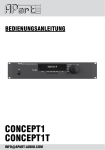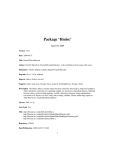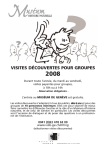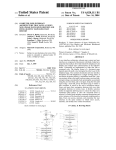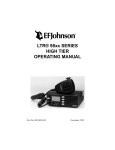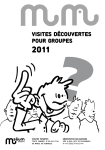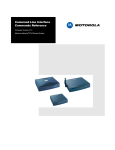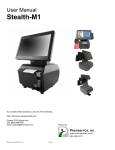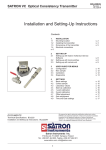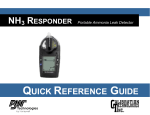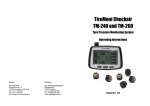Download LTR-NET SERVICE MANUAL ADDENDUM, PART NO. 001
Transcript
LTR-NET SERVICE MANUAL ADDENDUM, PART NO. 001-9800-600 REVISIONS This revision describes changes and additions that have occurred through March 2000 to the LTR-Net Service Manual Addendum, Part No. 001-9800-600, with a printing date of April 1999. Add this change information to your copy of this manual. SECTION 1 GENERAL INFORMATION UPDATES CAUTION: When power is turned off with an LTRNet system selected, the transmitter automatically keys briefly to transmit a de-registration message. 1.3 TRANSCEIVER IDENTIFICATION NUMBER The illustrations on page 1-1 are reversed and the type information in the identification number breakdown illustration has changed. The correct illustration is as follows: Identification Number Breakdown Warranty Revision Manufacture Plant Number Letter Date Model From P.N. 98xx x A 10 9 A 1 = Low pwr LTR 2 = High pwr LTR 3 = High pwr Data MN 4 = Low pwr LTR-Net 5 = High pwr LTR-Net 6 = Low pwr Multi-Net 7 = High pwr Multi-Net 8 = Low pwr Data LTR 9 = High pwr Data LTR 0 = Low pwr Data MNet Last Digit of Year Week No. of Year NOTE: Low power = 25W UHF, 15W 800/900 MHz; High power = 40W UHF, 30W 800/900 MHz) 1.4 PART NUMBER BREAKDOWN The illustrations on page 1-1 are reversed and the options information in the part number breakdown illustration has changed. The correct illustration is as follows. Part No. 001-9800-601 242 - 9 8 x x -x x x x Band 1 = VHF* 4 = UHF 8 = 800 MHz 9 = 900 MHz Type 1 = Low tier, dual BW 2 = Mid tier, dual BW* 3 = High tier, dual BW 4 = Low tier, 12.5 kHz 5 = Mid tier, 12.5 kHz* 6 = High tier, 12.5 kHz 8 = High tier rem, dual BW 0 = High tier rem, 12.5 kHz Signaling 2 = LTR 4 = Multi-Net 6 = LTR-Net 8 = Data LTR 9 = Data M-Net 0 = Conv only* Options [1] B/N = Comp/Data C/O = Compander D/P = Data Cable E/Q = Enc/Comp F/T = Enc/Comp/Dat G/U = Comp/Acsry H/V = Horn/Acsry I/W = Enc/Comp/ Acsry Cable [1] N-W models are LTR-Net upgradable Config. 2 = Low Pwr std 3 = High Pwr std 7 = L.P. no acc 8 = H.P. no acc Freq Range 0 = Full band (800/ 900 MHz) 3 = 430-470 MHz 5 = 470-512 MHz * These configurations are currently not available. 12345 A = Waseca Type Part Number Breakdown 1.5.3 KEY CAP KIT The key cap kits have changed. Key Cap Kit, Part No. 587-9840-002, is included with each transceiver. This kit includes the five caps indicated by an asterisk (*) below. Optional key cap kit, Part No. 587-9840004, is also available which includes all of the caps in the following list. FCN* TA C/G CPND EMER (Blank) SCAN* AUX PRI MHNG ENCPT (Blank) A/D* HOME USR1 STLH Rx PA ROAM* PAGE USR2 MICPA CALL TEL* HORN MON BANK To remove a key cap, insert a tool with a sharp tip in the slot on the bottom of the cap and carefully pry against the front panel to release the cap. 03-00hph Printed in U.S.A. transceiver with new operating software (firmware). More information on Flash programming is located in Section 3.12 of the service manual addendum. CONNECTING TRANSCEIVER POWER For the transceiver to de-register and save the current states of the various functions when power is turned off, power to the transceiver must be maintained for a time after power is turned off. Therefore, observe the following when installing the transceiver and turning power off: • 4. Tune Program (P.N. 023-9998-416) - This program is called PLATUNE, and it is used to set parameters such as frequency, modulation levels, and power output. The tuning procedure is described in Section 7 of the 98xx LTR Service Manual, Part No. 001-9800-20x. Connect the transceiver power cable to an unswitched power source such as the battery. Do not connect it to a switched source such as the ignition switch or a relay. • Make sure that power is always turned off using the front panel power switch or the ignition sense input of the accessory cable. • Program the power-off delay as follows: The following are the general steps that are performed in order to field tune the radio. The files needed to perform this procedure are available on the E.F. Johnson ACES® BBS system for downloading. Contact the Customer Service Department at 1-800328-3911 or (507) 835-6911 for additional information on obtaining these files and performing this procedure. 1. Using the LTR-Net Personality Program, read the personality information currently in the transceiver and store it in a disk file so that it can be restored when tuning is complete. – If the ignition sense input is used, program the Ignition Sense Delay parameter on the Main Radio Parameters > Timing Parameters screen for the desired delay (“Immediate” is allowed). 2. Using the Flash (PLATUPD) program, reflash the transceiver with standard LTR/conventional high tier 98xx operating software. The correct .S19 file must be in the same directory as the program. – If the ignition sense input is not used, program this Ignition Sense Delay parameter for “Forever”. This prevents improper operation when the vehicle is started. 3. When finished, turn power off and disconnect the programming cable. When power is turned back on, it is normal for the display to indicate “PROG ERR” because the LTR-Net personality information is not compatible with the LTR operating software. TRANSCEIVER TUNING The 98xx LTR-Net transceivers can now be field tuned using a special procedure which re-Flashes the transceiver with temporary operating software. The following programs are required to tune this radio: 4. Using the LTR Personality Program (PLATFORM), program a basic LTR personality. 1. LTR-Net Personality Program (P.N. 023-9998457) - This program is called LTRNetMobPgmr, and it programs the information which changes from radio to radio. This program is described in Section 3 of the 98xx LTR-Net service manual addendum. 5. The Tune (PLATUNE) program can now be used. Using that program, tune the transceiver as described in Section 7 of the 98xx LTR Service Manual, Part No. 001-9800-20x. 6. Using the Flash Program, reflash the transceiver with the current LTR-Net operating software. The display will again indicate “PROG ERR” because the LTR personality information is not compatible with LTR-Net operating software. 2. LTR Personality Program (P.N. 023-9998-414) This program is called PLATFORM, and it programs the information which changes from radio to radio. This program is described in Section 4 of the 98xx LTR Service Manual, Part No. 001-9800-20x. 7. Using the Personality Program, reprogram the transceiver with the original personality information read out in step 1. 3. Flash Program (P.N. 023-9998-432) - This program is called PLATUPD, and it programs the 2 SECTION 2 OPERATION UPDATES For example, assume that the group select mode is the default and the time delay is 3 seconds. It is then in the group select mode when power is turned on, and if the system select mode is selected, it returns to the group select mode 3 seconds after a change is made. INTRODUCTION The following are the main operating enhancements that have been made since the addendum was printed. Refer to the sections which follow for more information on these enhancements and other operation changes that have occurred. 2.4.6 MICROPHONE OFF-HOOK DETECT • A hanger switch can be programmed to manually select an off-hook condition when off-hook detection has been disabled by programming. • Voice encryption is now available. • Horn alert is now available. • A proceed tone delay can now be programmed on each group. In addition, the proceed tone can be enabled or disabled on LTR/LTR-Net telephone and auxiliary calls. • LTR-Net mode scanning has been enhanced to allow LTR and conventional systems to be scanned if the current LTR-Net site is lost and another cannot be detected. This can provide uninterrupted operation when traveling through areas which have not yet been converted to LTR-Net operation. When microphone hanger detect is disabled on a radio-wide basis by selecting the “Disable Mic Hanger” box on the Basic Parameters screen, a Hanger option switch can be programmed. This switch allows an off-hook condition to be manually selected. An offhook condition disables scanning, and when a conventional system is selected, it enables the monitor mode. When the off-hook mode is selected by this switch, “OFF HANG” is displayed on the bottom line. Then when the on-hook mode is selected, “ON HANG” is displayed. On power-up, the on-hook mode is always selected. Each conventional group can be programmed so that monitoring is not enabled by an off-hook condition. The monitor mode then cannot be selected by the microphone hanger or the Hanger option switch (although scanning is still disabled). 2.4.5 SELECTING SYSTEMS AND GROUPS The Select switch default select mode and return time are now programmable (previously the Select switch always remained in the last selected mode). Therefore, the paragraph above “Group Tracking” on page 2-5 should be changed to read as follows: 2.5.1 BANK SELECT Each bank can now be programmed with a default scan enable status. When a Scan option switch is not programmed, this permits scanning to be automatically enabled or disabled when the bank is selected. If a Scan option switch is programmed, the default bank scan status is valid only until the first time it is changed by this switch. Programming of the “Select Knob Default” parameter on the Basic Parameters screen determines if the transceiver reverts to the system or group select mode. Then the programming of the “Select Knob Return” parameter on the Timing Parameters screen determines the delay in returning to the default mode after a change is made. This timer is programmable for 0-8 seconds. Programming “0” causes the transceiver to remain in the selected mode until it is changed again. The default mode is always reselected when power is turned off and then on again. The default scan list status of each system in a bank can also be programmed. When a SCN SAVE menu parameter is not enabled, this permits the scan list status of the system to be set on a per bank basis. If a Scan Save option switch is programmed, the default scan list status is valid only until the first time it is changed by this switch. 3 The user selected parameters stored on a per bank basis are the last selected system, scan mode, and the scan list status of each system. Therefore, when the bank is reselected, these parameters return to the last selected state in that bank. be programmed for encryption. Encrypted calls are always received regardless of the currently selected encryption mode or group programming (as long as the transceiver is equipped with the encryption module). 2.5.5 ENCRYPTION When transmitting an encrypted call, the user should wait approximately 1 second before speaking. This gives the receiving transceiver time to establish synchronization which ensures that all of the first word is received. If the proceed tone is used and an encrypted call is transmitted, two beeps sound instead of one to indicate an encrypted call. A proceed tone delay can also be programmed so that it does not sound until speaking can begin. Refer to the “Proceed Tone” description on page 5 for more information. Encryption is now supported by the operating software. This is an optional feature that prevents conversations from being monitored by casual eavesdropping and analog scanners. It does this by encrypting the voice so that it can be understood only by someone using a transceiver equipped with a similar encryption device. To have this feature, a separate encryption module is installed in Option Slot 1 on the audio/logic board, and the transceiver must be programmed for encryption as follows: 2.5.8 HORN ALERT • Program the control line for this function as described in Section 3.13.3 of the service manual addendum. • Each group on which encryption is to be used must be programmed for that feature. To do this, first enable encryption on by checking the “Encryption Installed” box on the Edit > Mobile Radio Parameters > Basic Parameters screen. Then check the “Encryption Available” box on the applicable group screens. • The ENCRYPT menu parameter or ENCPT option switch can be programmed to enable or disable encryption. Encryption can also be fixed in the enabled mode if neither of these is programmed. GENERAL The horn alert feature is now supported by the operating software. This feature activates an external alert such as the vehicle's horn or lights when calls are received on groups programmed for this feature. When the horn alert is enabled either manually or automatically as described in the following information, is displayed as shown in the following illustration. The alert on and off times are each programmable for 0.25, 0.50, 0.75 or 1.0 second, and the number of cycles are programmable for 1-8. Horn Alert Enabled When encryption is enabled by the menu parameter, option switch, or programming, is indicated in the display as shown below. However, this icon does not indicate if the selected group is programmed for encryption. OPERATION IN MODES “A” AND “B” The horn alert is programmed to operate in Manual Mode A or Automatic Mode B (see descriptions which follow). In Manual Mode A, the on or off condition is selected using the HRN ALRT menu parameter. In Automatic Mode B, the on or off condition is selected automatically and the current mode cannot be changed using the menu parameter. Therefore, the HRN ALRT menu parameter should be programmed only when Mode A is used. Encryption Indicator To transmit an encrypted call, encryption must be enabled as just described and the selected group must 4 encrypted call (see preceding Section 2.5.5), a special double tone always sounds. A power-off delay can be programmed to occur when power is turned off by the ignition switch (see Section 2.5.10 in the service manual). The horn alert can then remain active for a time after the ignition is turned off. Calls On Which Proceed Tone Sounds - The proceed tone always sounds with LTR-Net and LTR dispatch calls (if tones are enabled by the TONES menu parameter or programming). It can also be programmed to sound with the following calls: Mode A (Manual On/Off) The current horn alert mode does not change when power is turned on or off by either the ignition switch or power switch. Therefore, the horn alert is totally controlled by the HRN ALRT menu parameter. Mode B (Automatic On/Off) The horn alert always turns off when the power switch or ignition switch is turned on, and always turns on when the ignition switch is turned off (if there is a power-off delay programmed). Therefore, the ignition switch must always be used to control power with this mode. If only the power switch is used, a poweroff delay is not available and the horn alert is always disabled. • To enable it on conventional calls, check the “Conventional Enabled” box in the Edit > Mobile Radio Parameters > Basic Parameters screen. • To enable it on LTR-Net and LTR telephone and auxiliary calls, check the “Conversation Enabled” box in the Basic Parameters screen. Proceed Tone Delay - The proceed tone normally sounds almost immediately when the PTT switch is pressed. However, if the user should wait a short time after pressing the PTT switch before speaking, for example when wide area calls are placed, a delay of 0-2.5 seconds can be programmed in the Timing Parameters screen. This delay can then be enabled on each group by checking the “Delayed Proceed Tone” box. If this box is not checked, no delay occurs. NOTE: The HRN ALRT menu parameter cannot be used to change the automatically selected on-off condition in this mode. PERMANENTLY ENABLING HORN ALERT 2.7.3 LTR-NET MODE SCANNING Mode A - If the HRN ALRT menu parameter is not programmed, the horn alert feature can be permanently enabled by programming the horn alert default to “ON”. The horn alert is then always enabled and there is no way for the user to turn if off. LTR and conventional systems are now scanned in the LTR-Net mode in certain conditions. Previously, only the LTR-Net systems in the scan list that accessed the current locality were scanned. Several more proceed tone parameters are now programmable. The proceed tone programmable parameters are as follows: When both roaming and system scan are enabled, registration on other sites occurs and the only systems scanned are LTR-Net systems that are in the scan list and programmed for the current site. However, if no LTR-Net locality could be located during locality search, LTR and conventional systems that are in the scan list are also scanned. If a signal is detected on one of those systems, the transceiver moves to it. However, searching continues for a programmed LTR-Net locality, and when one is detected, registration on that site occurs and only LTR-Net systems are again scanned. Type - A standard (single) or distinctive (triple) proceed tone can be programmed. When transmitting an This operation can provide uninterrupted operation when traveling through areas which have not yet Mode B - The programmed default condition has no affect on operation because it remains in effect only until the first time it is automatically changed as described above. 2.5.8 PROCEED TONE 5 been converted to LTR-Net operation. Other scan operation in this mode remains unchanged as follows: • If Roaming = Off and System Scan = On with an LTR-Net system selected, LTR-Net systems that are in the scan list and programmed for the current site are scanned and LTR and conventional systems are never scanned. • If Roaming = On and System Scan = Off with an LTR-Net site selected, registration on other LTRNet sites occurs, but LTR and conventional systems are never scanned. • If Roaming and System Scan = On with an LTR or conventional system selected, all system types are scanned as described above. MISCELLANEOUS UPDATES Conventional Operation - In Sections 2.1.5 and 2.4.8, the manual incorrectly states that each conventional system selects a block of 99 channels and each group selects a channel from that block. It should state that each conventional system selects a specific radio channel, and each group selects Call Guard squelch coding and other unique parameters such as call indicator operation for that channel. A conventional locality can be programmed with up to 20 conventional channels. Receive-Only Groups - Receive (monitor) only groups can be programmed in all operating modes so that transmitting is automatically disabled. To program receive-only LTR-Net or LTR groups, program an encode ID of “Disabled”. To program receive-only conventional groups, on the group screen select Tx Option = Disabled. If the PTT switch is pressed with one of these groups selected, the intercept tone sounds and “TX DISBL” is displayed. If Roaming = Off and System Scan = On with an LTR or conventional system selected, only the LTR or conventional systems in the scan list are scanned. 2.8.1 RECEIVE PRIORITY CALLS Menu and Option Switch Table - The table on page 2-13 which summarizes the available menu parameters and option switches needs to be updated to show the encryption, horn alert, and hanger functions. The updated table is shown on the next page. The following is additional information regarding receive priority on LTR and LTR-Net systems. If any type of call (standard, telephone, auxiliary) is detected on any group of the selected system that has a higher priority than the selected group or the call being received, it is received even if group scanning is not enabled. Exceptions are if the group is not in the group scan list or the current call is on a group programmed as not interruptible. System Access When Busy - The “Busy Tone” description on page 2-26 incorrectly states that no more accesses are made once the busy tone starts sounding. Actually, access attempts continue when a busy condition is being indicated; therefore, a system can be accessed by holding the PTT switch down. When not group scanning, standard calls with a lower priority than the selected group are never received. However, telephone and auxiliary calls of any priority are received if on a group in the group scan list and no other call is being received. If another call is being received, they are received only if they have a higher priority than the current call. When group scanning is enabled, calls are received on all groups in the scan list regardless of priority. Displaying Software Version Number - Section 2.13.2 states that when power is turned on with the two top switches pressed, the software version number is displayed on the bottom line. This has been changed so that it is now displayed on the top line and any error codes are displayed on the bottom line as shown in the following illustration. The priority 1 and 2 groups of LTR and LTR-Net systems are now indicated in the display. Therefore, when any priority 1 group in the current system is displayed, is indicated in the upper part of the display, and when any priority 2 group is displayed, is indicated. Software Version No. Error Code 6 using the programming software. The programmer function for doing this has been moved from the “File” to the “Transfer” menu. Therefore, the last line of the first paragraph should be changed to the following: Connect the programming setup and then select Transfer > Read *Codes or click the icon in the toolbar. The software version number and other information can now also be displayed using the programming software by selecting Transfer > Read Factory Info. Refer to “Programming Updates” on next page for more information. Reading Error Codes - The first paragraph of Section 2.14.2 describes how to read the error codes Table 2-1 Menu Mode and Option Switch Functions Function Add/delete (scan list programming) Backlight adjust Bank select Display mode select Emergency Encryption on-off Function select Hanger (on-off hook select) Home sys/grp select Menu Items BACKLGHT BANK SEL S/G DISPL ENCRYPT Horn/light alert on-off Menu mode select HRN ALRT Option select Roaming on-off Scan on-off Scan type select Scan continue on-off Scan list save mode Stealth mode select Squelch adjust OPTION ROAMING Telephone group select Tone type select Option Switch See Section: A/D 2.7.6 2.4.3 2.5.1 2.4.4 2.5.4 2.5.5 2.5.6 2.4.6 2.5.7 BANK EMER ENCPT FCN MHGR HOME or FCN then press Sel Sw MENU or FCN twice AUX ROAM SCAN SCN TYPE SCN CONT SCN SAVE STEALTH FCN then rotate Sel Sw TEL TONES NOTE: Parameters left blank are not available. 7 2.5.8 2.6.2 2.5.9 2.9.3 2.7 2.7 2.7.7 2.7.6 2.5.13 2.4.7 2.8.5 2.5.15 SECTION 3 PROGRAMMING UPDATES Title Bar Menu Bar Toolbar - Status/ Function Flash Memory EEPROM Left Memory Left Radio Type Being Programmed Status Bar - Figure 3-2 Main Window fewer localities, systems, groups, or banks must be programmed. 3.3 MAIN WINDOW DESCRIPTION The main window has changed somewhat. The updated main window is shown in Figure 3-2 above, and the changes are as follows. • The right pane now displays a text file of the information in the current radio file. This text file can be printed by selecting File > Print. • The left pane shown above can be turned on and off by selecting View > Personality. It displays the current programming information in a selectable Locality, Bank, or System hierarchy. • The radio model has moved from the title bar to the status bar. • The icon has been added at the end of the toolbar. This button can be clicked to read various version information from the transceiver (see “Transfer Menu” on page 9). • 3.5 FILE MENU The “Read Codes” function has been moved to the Transfer menu (see “Transfer Menu” on page 9). In addition, a “Print” function has been added to print the text file being displayed in the right pane. 3.6.3 BASIC PARAMETERS SCREEN The Basic Parameters screen on page 3-8 has been changed to program additional proceed tone parameters (the updated screen and descriptions follow). Refer to “Proceed Tone” on page 5 for more information. Proceed Tone Type - Selects either a standard (single) or distinctive (triple) tone. Conventional Enabled - When selected, the proceed tone sounds with conventional calls in addition to LTR-Net/LTR dispatch calls. The information in the status bar has changed slightly. If the number in any of the “memory left” displays reaches zero before all data is entered, 8 Refer to “Proceed Tone” on page 5 for more information. Conversation Enabled - When selected, the proceed tone also sounds with LTR-Net/LTR telephone and auxiliary calls. NOTE: The select knob default and horn alert features are now available, so parameters relating to those parameters in this screen are now functional. Display Emergency - Currently, this parameter is not used. The group alpha tag is always displayed (if programmed) when the emergency switch is pressed (see Section 2.5.4 in the service manual addendum). MENU AND OPTION SWITCH TABLE (PG 3-11) NOTE: The select knob default, horn alert, and encryption features are now available, so the parameters relating to those features are now functional. In the “Menu and Option Switch Parameter Descriptions” table on page 3-11, the following changes should be made: • The “Horn Alert On-Off” parameter is available only as a menu item and not an option switch. Therefore, there should not be an “X” in the Option Switch column. • The Encryption, Horn Alert, and Mic Hook Sel (Hanger) functions are now available, so Note [1] should be ignored. 3.7 TRANSFER MENU Updated Basic Parameters Screen 3.6.4 TIMING PARAMETERS SCREEN The “Read *Codes” and “Read Factory Info” parameters have been added to the Transfer menu shown above (“Read *Codes” was previously in the File menu). These parameters function as follows: Read *Codes - This menu item or toolbar icon reads the error code log stored in the radio and displays it. Refer to Section 2.14 in the service manual addendum for more information. The Timing Parameters screen on page 3-9 has an additional parameter for programming the proceed tone delay time (see screen above). Proceed Tone Delay - This programs how long the proceed tone is delayed after the PTT switch is pressed on groups with the delayed proceed tone feature enabled. Times of 0-2.5 seconds can be programmed. Read Factory Info - This parameter displays the preceding screen which indicates the following version 9 information for the transceiver connected to the computer. TABLE 3-6 (BANK PROGRAMMING SCREEN) (Page 3-20) ESN - Indicates the electronic serial number of the transceiver that is stored in the logic. The layout of the bank programming screen has been changed somewhat (see updated version below). In addition, the “Bank Scan Enable” parameter has been added. The scan parameters in this screen are as follows. Refer to “Bank Select” on page 3 for more information. Warranty Info - This is the transceiver identification number described in Section 1.3 (see additional information on Section 1.3 on page 1). Radio Config - These are digits 4-11 of the transceiver part number described in Section 1.4 (see additional information on Section 1.4 on page 1). Software Version - Indicates the version of operating software contained in the radio. 3.8 VIEW MENU Bank Scan Enable - Programs the default scan status (on or off) when the bank is selected. If the Scan option switch is not programmed, this allows the scan status on the bank to be fixed in the on or off mode. When the View > Personality menu item is selected, the left pane is displayed in the main screen (see illustration on the top of page 8). Either the Locality, Bank, or System view type can be selected to display the desired hierarchy. Add To Scan List - Programs the default scan list status of the selected system in that bank. If the Scan List Save menu parameter is not programmed, this allows the scan list status of that system to be fixed in that bank. To quickly display the data programmed for a locality, bank, or system displayed in this pane, simply click it. This pane is always displayed whenever the program is started. To turn it off, simply select View > Personality. 3.13.3 ENCRYPTION PROGRAMMING TABLE 3-5 GROUP PROGRAMMING SCREEN (Pages 3-18/3-19) Delete the “NOTE” in this section because encryption is now supported by software. The “Delayed Proceed Tone” parameter has been added to allow that feature to be enabled or disabled on each group. The changed section of the LTR/ LTR-Net screen is shown below. MISCELLANEOUS The programming software is now shipped on two or more 3-1/2” diskettes. Added 10
















